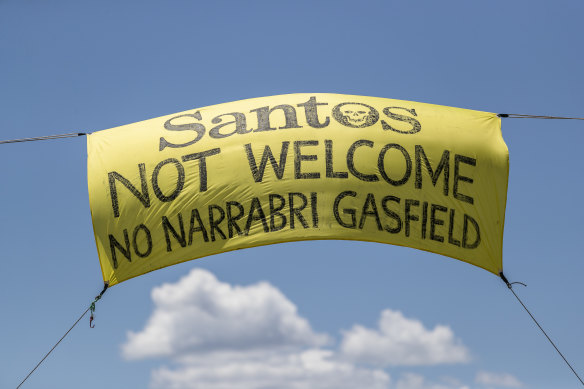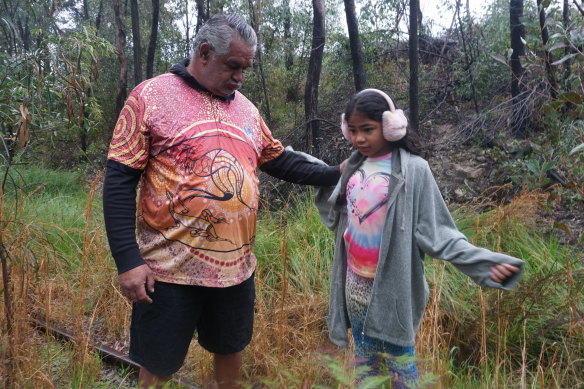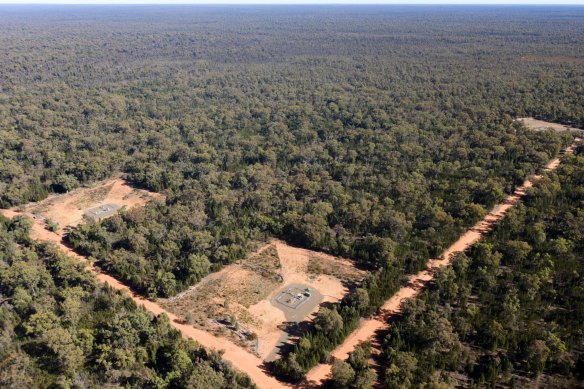The National Native Title Tribunal has ruled in favour of a $3 billion gas development in northern NSW that will allow Santos to drill more than 850 coal seam gas wells in the native Pilliga Forest over the next 25 years, but local Indigenous Australians say they will appeal against the decision.
A group of First Nations people who have applied for native title of the Pilliga area, which is in Gomeroi country, have fought against Santos’ development for years on cultural and environmental grounds.

But on Tuesday, the tribunal – which manages native title applications and is not comprised of Aboriginal Australians – determined the group had failed to prove the gas project would have “grave and irreversible consequences for the Gomeroi people’s culture, lands and waters and would contribute to climate change”.
Tribunal president and judge John Dowsett said in his decision that Santos had negotiated in good faith and the benefits the Narrabri-Pilliga gas project would provide to the region and wider country significantly outweighed the Gomeroi people’s concerns.
Pilliga Forest spans more than 500,000 hectares in northern NSW and is recognised as one of the most important areas for biodiversity in eastern Australia. It is home to at least 300 native animal species and more than 900 plant species, and is the largest remaining area of native forest west of the Great Divide.
Gomeroi man Raymond Weatherall, a member of an 18-person representative body for the native title claimants, said the group would appeal against the decision.

He said it was a sad day for the Gomeroi people.
“We’re trying to uphold our cultural integrity. The proposed infrastructure [for the wells] seeks to destroy our cultural heritage and spiritual connection to our Country,” he said on Tuesday.
“It’s despicable that they wait until the last sitting day of the year to announce this. But we won’t give up, it doesn’t matter what it takes. It’s been a long campaign, 10 years long. We know they always shift the goalposts. We’ll keep fighting.”
The gas project is subject to one condition: that Santos “take all necessary steps” to implement all provisions identified in the scheme’s Aboriginal cultural heritage management plan before the next phase of the project. The company is required to publish modelling of management plans for groundwater, biodiversity and other environmental impacts.

The Gomeroi group, which applied for recognition of their native title in December 2011, has led a coalition of groups opposing the gas project, arguing the process of fracking will pollute waterways that crisscross the Pilliga and the groundwater beneath it, including the Great Artesian Basin.
Santos went to the tribunal after a confidential offer was rejected by the Gomeroi group in March.
After the group rejected Santos’ offer, the gas giant made several Future Act applications. A Future Act is a proposal to deal with land that affects native title rights and interests. The Native Title Tribunal decides which proposals can go ahead. Of the dozens of decisions made by the tribunal over the years, only a handful have come back in favour of First Nations people.
Gomeroi woman Suellyn Tighe, from Coonabarabran, said the approval was “true to form” for the tribunal and it was now time for “boots on the ground” mobilisation.
“This is another example of how politicians and profits are more important than people. And again it’s at the cost of Aboriginal people’s cultural and ancestral lands. It’s a shameful day for Australia, that it has again disregarded the First Nations people. The tribunal along with the major political parties should hang their heads in shame over this decision,” Tighe said.
“The upshot of the decision is to say that the profits of large fossil fuel companies [are] more important than the Gomeroi cultural heritage values. It shows us how little they think of Aboriginal people, unless it is an advertising campaign for tourist dollars.”
In a statement, Santos said it would “continue to engage constructively with the Gomeroi people and work closely with them to ensure their heritage is protected and they benefit from the project development in a range of ways”.
The company said the project offered the Gomeroi people training and employment opportunities, and involvement in cultural heritage protection and management. It said it would ensure Australia’s energy security and affordability into the future.
The federal and NSW governments gave the go-ahead to the Narrabri-Pilliga gas project in 2020. Australia’s largest onshore natural gas reserves lie beneath the Pilliga forest and they could be sufficient to supply current levels of NSW gas demand for the next 50 years, according to reports released by Santos.
Santos expects to spend $3.5 billion developing the project, creating 1300 jobs during the construction phase and 200 ongoing jobs during operations. The project seeks to tap up to 1500 petajoules of gas reserves in the Narrabri-Pilliga region, with an expected daily production of up to 200 terajoules, which represents about half of NSW’s current gas consumption.
The gas field is expected to contribute almost 130 million tonnes to Australia’s greenhouse gas emissions over the life of the project, according to the Climate Council.
The Environment Protection Authority investigated Santos over two wastewater spills in 2014. In March, the watchdog fined Santos $1500 for a “pollution incident” that contaminated an aquifer, with uranium at levels 20 times higher than safe drinking water guidelines.
The second spill involved the release of about 500 litres of “produced water”, which entered a diversion drain. There were four separate wastewater leaks at Santos wells in the same area between June 2011 and February 2012, with toxic heavy metals – including arsenic, lead and chromium – detected, plus traces of petrochemicals in water and earth samples taken in the Pilliga Forest area.
One 10,000-litre spill of polluted water in June 2011 went unreported for several months before Santos acquired operations later that year from Eastern Star Gas. Three subsequent wastewater spills on a smaller scale were reported by the company over the following months, though it maintained none of the leaks occurred near watercourses and they presented no risk to the environment.
